
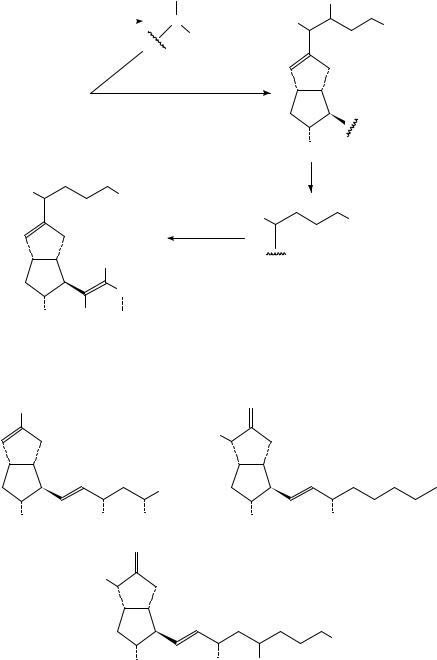
18. Syntheses and uses of isotopically labelled dienes and polyenes |
795 |
|||
|
|
D |
(SO2 Ph)2 |
|
|
|
|
|
|
CH2 Cl2 |
/ ClCOOMe / pyridine |
CH |
D |
|
|
|
|
||
|
|
|
||
|
0 °C, 10 min |
|
COOMe |
|
|
|
|
OCOOMe |
|
Pd2 (dba)3 CHCl3 − Ph2 PCH2 CH2 PPh2
(PhSO2 )2 CH(CH2 )2 COOMe, THF, 15 h reflux
OR
(22 continued )
35 °C, 2 h Mg / MeOH
D
COOMe
D
COOMe
n-Bu4 NF / THF
RT, 5 h separations
D
CH(CH2 )4 Me
OH D OH
(55)
b. The [2,2,3,3,4,4-2H6] derivative 56 has been prepared48 starting with tetrahydrofuran- D8 (equation 23). Similarly, the derivatives 57 and 60 have been prepared as shown in
CH2 (CD2 )3 COOMe
|
|
|
HO |
|
|
|
|
(CH2 )3 R |
|
OH |
OH |
R |
OR |
OR |
(56) R = H, |
(57) R = Me |
(58) R = SiMe2 Bu-t |
|
|
HO
Me
OR |
OR |
Me |
(59)

796 |
Mieczyslaw |
Zielinski´ and Marianna Kanska´ |
equation 24. The polydeuteriated isocarbacyclin derivatives 55, 56 and 57 have been obtained for use as internal standards in GC/MS quantitative analysis and for use as substrates in metabolic studies.
D2 C |
|
CD2 |
|
1. MeCOBr, ZnCl2 , 0 °C |
|
Br(CD2 )4 OCOMe |
LiA lH4 |
Br(CD2 )4 OH |
|||||||||||
D2 C |
|
CD2 |
|
|
|
|
|
|
|
|
|
||||||||
|
|
2. RT, 30 min |
|
|
|
||||||||||||||
|
|
|
|
|
|
|
|
|
|
|
|
|
|||||||
|
O |
|
Br(CD2 )4 OTHP |
|
CH2 Cl2 , dihydropyran, pyridinium - O Ts |
|
|||||||||||||
|
|
|
|
||||||||||||||||
|
|
|
|
|
|
||||||||||||||
|
|
|
|
|
|
|
|
|
|
|
|
|
|
|
|||||
|
|
|
|
|
|
|
|
CH2 (CD2)4 OTHP |
|||||||||||
|
|
|
|
|
|
|
|
|
|
|
|
|
|||||||
|
|
1. t-BuLi / ether |
|
|
|
|
|
|
|
|
|
|
|
|
|
|
|||
|
|
|
|
|
|
+ |
|
|
|
|
|
|
|
|
|
|
|
|
|
|
|
2. 58, n-BuLi, CuI, n-Bu3 PNMePhI − / DMF |
|
|
|
|
|
|
(CH2 )4 Me |
||||||||||
|
|
|
|
|
|
|
|
|
|
|
|
|
|
|
|
|
|
|
|
R = SiMe2 Bu-t |
|
|
|
|
|
|
|
OR |
|
|
|
OR |
|||||||
|
|
|
|
|
|
|
|
|
|
|
|
|
|
|
|
||||
|
|
|
|
|
|
|
|
|
+ |
|
|
|
|
|
|
R = SiMe2 Bu-t |
|||
|
|
|
|
|
|
|
n-Bu3 PNMePhI − / THF |
|
|
|
|
||||||||
|
|
|
|
|
|
|
A c2 O / pyridine |
|
|
|
|
|
|
|
|||||
|
|
|
|
|
|
|
|
|
|
|
|
|
|
|
|
|
|
|
|
|
|
|
|
|
|
(CH2 )4 Me |
|
|
|
|
|
|
|
|
|
|
(CH2 )4 Me |
||
|
OH |
|
OH |
|
|
|
|
|
|
|
|
OAc |
|
OAc |
|||||
|
|
|
|
|
|
|
|
|
|
|
|
|
|
|
|
|
|||
|
|
|
|
|
|
|
|
|
|
|
|
|
|
|
deprotection |
p-TsOH |
|||
|
|
|
|
|
|
|
|
|
|
|
|
|
|
|
of THP ether |
|
|
||
|
|
|
|
|
|
|
|
|
|
J ones’reagent |
|
|
|
|
|
|
|
||
|
|
|
|
|
|
|
|
|
|
|
|
CH2 |
(CD2 )4 OH |
||||||
|
|
|
|
|
|
|
|
|
|
|
|
|
|
|
|||||
|
|
|
|
CH2 (CD2 )3 COOH |
acetone, 0 °C, 30 min |
|
|
||||||||||||
|
|
|
|
|
|
|
|
|
|
|
|||||||||
|
|
|
|
|
|
|
|
|
|
|
|
|
|
|
|||||
|
|
|
2. KHSO4 |
|
1. NaOH / MeOH |
|
|
|
|
|
|
|
|||||||
|
|
|
3. extraction |
|
1.5 h |
|
|
|
|
|
|
|
|
|
|
|
|||
|
|
|
|
|
|
|
|
|
|
|
|
|
|
|
|
|
|
|
|
|
1. MeCN, MeI / i-Pr2 NEt |
|
|
(CH2 )4 Me |
18 h stir |
56 |
|
2. Work-up, |
|||
|
|
separation by HPLC
OH OH
23
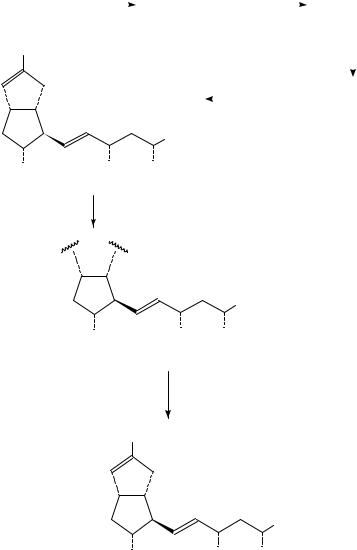
18. Syntheses and uses of isotopically labelled dienes and polyenes |
797 |
||||||||
Br(CD2 )4 OH |
J ones’reagent |
Br(CD2 )3 COOH |
MeOH / H2 SO4 |
|
Br(CD2 )3 COOMe |
|
|||
|
5 h reflux |
|
|||||||
|
|
|
|
|
|
|
|||
|
|
|
|
|
|
|
|||
CH2 (CD2 )3 COOMe |
|
|
EtCOMe, 10 h reflux |
NaI |
|
||||
|
|
|
1. Zn, CuCN - LiCl / THF |
|
|
|
|||
|
|
|
I(CD2 )3 COOMe |
|
|||||
|
|
|
2. 59, n-BuLi, TsCl |
|
|
||||
|
|
|
|
|
|
||||
|
|
CH2 (CH2 )2 Me |
|
|
|
||||
OR |
OR |
Me |
|
|
|
||||
+−
2.aqueous KHSO4 1. n-Bu4 NF / THF / RT, 10 h
(24)
|
|
|
CH2 (CH2 )2 Me |
|
OH |
OH |
Me |
|
|
(57) |
|
2. |
aq. KHSO4 , extractions |
1. LiOH / MeOH, RT, 4 h |
|
3. |
Silica gel chromatography |
|
|
CH2 (CD2 )3 COOH
|
|
CH2 (CH2 )2 Me |
OH |
OH |
Me |
|
(60) |
|
17. Synthesis of [7-2H]-, [7-3H]- and [2,2,3,3,4,4-2H6 ]-(16S )-15-deoxy-16-hydroxy- |
||
16-methyl-5-thiaprostaglandin E1 |
methyl ester, 61, 62 and 63 |
|
The prostaglandin E1 and E2 analogues showing antisecretory and cytoprotective activities49,50 had to be deuterium or tritium labelled for preclinical studies. The tritiated or deuteriated title compounds 61, 62 and 63 have been synthesized51 by the methods
outlined in equations 25, 26 and 27. Compounds 61 and 62, with hydrogen at 7-position
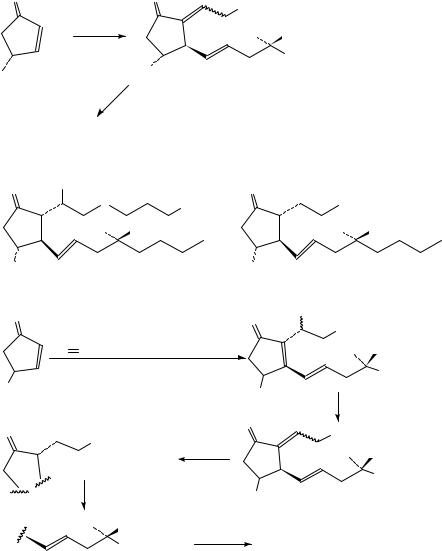
798 |
Mieczyslaw |
Zielinski´ and Marianna Kanska´ |
substituted by deuterium or tritium atoms, have been obtained by conjugate reduction of the enone function of the 7 olefinic precursor 64 with in situ generated tributyltin[2H]- or [3H]hydride in the presence of palladium(0) catalyst (equation 25). Compound 63 with hydrogen atoms at the 2,3,4-positions substituted by deuterium atoms has been synthesized51 as shown in equation 26, using the hexadeuteriated aldehyde 65 prepared in three steps (equation 27). Compound 63 has been used51 as internal standard in GC/MS analysis.
O |
|
O |
|
S(CH2 )3 COOMe |
|
|
|
|
|
|
|
||
|
three steps |
|
|
Me |
OH |
|
|
|
|
|
|
||
|
|
|
|
|
(CH2 )3 Me |
|
OSiMe2 Bu-t |
|
HO |
(64) |
|
|
|
|
|
|
|
|||
|
|
Pd(Ph3 P)4 , Bu3 SnCl - NaB(D or T)4 / MeOCH2 CH2 OMe / EtOH |
|
|||
|
61 or 62 |
|
|
|
|
|
61, 85% deuterium (by MS) |
|
|
|
|
(25) |
|
62, 146.8 mCi, 15% yield, specific activity |
|
|
|
|
||
13.8 mCi/mmol, 95% radiochemical purity |
|
|
|
|||
O |
R |
|
|
O |
|
|
|
|
|
|
|
||
|
S |
|
COOMe |
|
S(CD2 )3 COOR |
|
|
Me |
OH |
|
|
Me |
OH |
OH |
(61) R = D |
|
OH |
(63) R |
= Me |
|
|
|
|
||||
|
(62) R = T |
|
|
(66) R = H |
||
O |
|
|
|
O |
OH |
|
|
|
|
|
|
||
|
|
|
|
S(CD2 )3 COOMe |
||
|
|
|
|
|
||
CH2 CHI-t-BuLi, 1-pentynyl copper(I)-(Me2 N)3 P |
|
Me |
OSiMe3 |
|||
|
|
then 65 |
|
|
|
CH2 (CH2 )2 Me |
|
|
|
|
|
|
|
OSiMe2 Bu-t |
|
|
|
OSiMe2 Bu-t |
|
|
|
|
|
|
|
||
|
|
|
|
|
MsCl DMA P |
|
O |
|
|
|
O |
S(CD2 )3 COOMe (26) |
|
S(CD2 )3 COOMe |
|
|
||||
|
|
|
|
|
||
|
|
|
Pd(Ph3 P)4 |
|
Me |
OSiMe3 |
|
|
|
Bu3 SnH |
|
|
CH2 (CH2 )2 Me |
|
|
|
|
|
|
|
|
HF / Py |
|
|
OSiMe2 Bu-t |
|
|
|
|
|
|
|
||
|
Me |
|
|
DMAP = 4-dimethylaminopyridine |
||
|
OH |
|
|
|
|
|
|
|
porcine liver |
|
|
||
|
|
CH2 (CH2 )2 Me |
(deuteriated carboxylic acid) |
|||
|
|
esterase |
66 |
|||
|
|
|
|
|
|
|
(63)

|
18. Syntheses and uses of isotopically labelled dienes and polyenes |
799 |
||||||||
Br(CD2 )3 COOMe |
1. (NH2 )2 |
CS, then aq. NaOH |
|
HS(CD2 )3 COOMe |
|
|||||
|
|
|
|
|
|
|
||||
2. MeOH / H2 SO4 |
|
|
|
|
||||||
|
|
|
|
|
|
|
|
|||
|
|
|
|
|
|
|
|
|
NaH, DMF, (MeO)2 CHCH2 Br |
|
|
|
|
|
|
|
|
|
|
||
O |
|
|
|
|
|
|
|
|
|
(27) |
|
|
|
|
|
|
|
|
|
||
|
|
|
|
|
|
|
|
|
|
|
C |
S(CD2 )3 COOMe |
|
A cOH / H2 |
O |
|
(MeO)2 CHCH2 S(CD2 )3 COOMe |
|
|||
80 °C, 30min
H
(65)
18. Synthesis of multiply deuterium labelled prednisone and prednisolone
[1,19,19,19-2H4]Prednisone, 67, and [1,19,19,19-2H4]prednisolone, 68, containing four deuterium atoms at chemically stable sites, have been synthesized52 starting from [1,1,19,19,19-2H5]cortisone, 69 (equations 28a, 28b and 28c). No loss of deuterium from the C 19 and C 1 positions has been observed in the course of a synthetic sequence which involved the oxidation of the intermediates 70 and 71 with selenium dioxide in t-butanol. Route 28c has been less satisfactory because of the formation of by-products, especially in the oxidation of 71. Compounds 67 and 68 with 2H-label in chemically and biologically stable C 1 and C 19 positions are suitable for use in stable isotope methodology (coupled with GC/MS53,54) of investigations on steroid hormones in humans55.
|
|
CH2 OH |
|
|
|
|
|
|
C O |
|
O |
O |
|
|
|
|
|
|
||
|
O |
OH |
|
|
|
|
|
HCl / HCHO / CHCl3 |
O |
|
|
||
|
D |
|
O |
|||
D |
|
|
|
|||
CD3 |
H |
RT, 15 h |
|
|
|
|
|
H |
H |
|
|
|
|
O |
|
|
|
|
(70) |
|
|
(69) |
|
|
|
|
|
|
|
|
|
|
|
|
|
|
24 h reflux under A r |
|
|
CH2 OH |
|
|
|
|
SeO2 / t-BuOH |
|
|
|
|
|
|
|
|
|
|
|
D |
|
|
|
|
C O |
|
|
|
|
|
OH |
|
|
CD3 |
|
|
O |
|
|
|
|
|
|
|
|
|
|
|
|
D |
|
|
|
|
|
EtOH / THF, 46% HF |
CD3 |
H |
|
|
|
|
0 °C, 90 min, 2 − 5 °C, 12 h |
|
|||
|
|
|
|
|
||
O |
|
polyethylene test tube |
H |
|
H |
|
|
|
|
|
|||
|
(72) |
|
O |
|
|
|
|
|
|
|
|
|
|
|
|
(67) |
[1, 19, 19, 19 - 2 H4 ]-17α, 21-Dihydroxypregna- |
|||
|
|
1,4-diene-3,11,20-trione (prednisone-D4 ) |
28a |
|||
|
|
|
|
|
|
|

800 |
Mieczyslaw Zielinski´ and Marianna Kanska´ |
||||
|
|
|
D |
|
|
|
H2 NCONHNH2 .HCl |
|
|
CD3 |
|
72 |
|
|
|
|
|
in CH2 Cl2 / MeOH / Py |
|
|
|
|
|
|
|
|
|
|
|
|
RT, 40 h |
H2 NCONHN |
|
|
|
|
|
|
|
||
|
|
RT, 16 h, work-up, extractions |
|
|
|
|
|
|
O |
KBH4 / THF / H2 O |
|
|
|
|
|
|
|
|
|
|
O |
|
|
|
|
|
O |
|
|
|
HO |
|
O |
CH3 COOH / H2 O / A cOH |
|
|
D |
|
|
||
|
|
|
|
RT, 15 h |
|
|
CD3 |
|
H |
|
|
|
|
|
|
||
|
|
H |
H |
O |
CH2 OH |
|
|
|
|
||
H2 NCONHN |
|
HO |
|
OH |
|
|
|
|
|
|
|
(73)D
CD3 H
H H
O
(68) 55% yield
D
D CD3
H2 NCONHNH2 .HCl
70
H2 NCONHN
O
KBH4
O
HO
D
D CD3 H
73 |
SeO2 |
H |
H |
|
|
|
H2 NCONHN
deprotection at C3 and C17
(71)
68 + by-products
Presolone-D4 -BMD
EtOH / THF, 46% HF
28b
O
O
28c
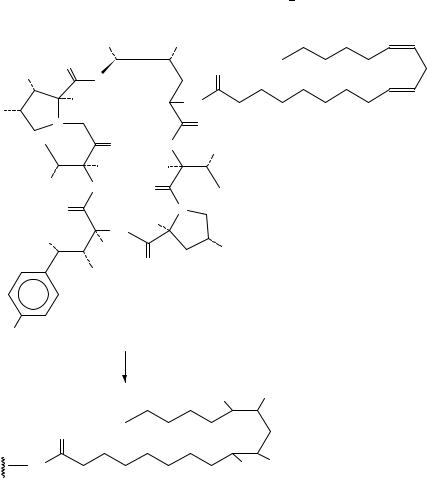
18. Syntheses and uses of isotopically labelled dienes and polyenes |
801 |
19. Synthesis of deuteriated and tritiated echinocandin B and anilinostearamide and the problem of HPLC isotope effects
Echinocandin B, 74, a macrocyclic peptide possessing antibiotic and antifungal properties56, has been catalytically reduced with hydrogen, deuterium or tritium57 (equation 29). The proton NMR and mass spectra of the reduction product 76 indicated that incorporation of deuterium exceeded saturation of double bonds. Four to ten deuterium atoms (with eight predominating) had been incorporated. This means that under the experimental conditions employed allylic labelling took place and a doublebond isomerization occurred during the reaction. Hydrogen deuterium exchange might be also occurring58.
|
|
HO |
|
OH |
|
HO |
|
O |
|
O |
|
|
NH |
|
|
||
|
|
|
|
||
|
|
|
|
|
|
|
|
H |
|
NH |
|
Me |
|
|
|
|
|
|
|
|
|
|
|
|
|
N |
|
O |
|
|
|
O |
HN |
OH |
|
|
|
|
|
|
|
|
|
H |
H |
|
|
|
HO |
NH |
O |
|
|
|
|
|
|
||
|
|
O |
H |
N |
|
|
|
NH |
|
|
|
|
HO |
|
|
|
|
|
H |
|
OH |
|
|
|
|
|
|
||
|
|
OH |
O |
|
|
|
|
|
|
(29) |
|
|
|
|
|
|
|
HO |
|
(74) |
|
|
|
|
EtOH, 25 °C, 2.5 − 5 h |
X2 (1 atm), 10 % Pd on C |
|
||
|
|
|
|
X |
X |
|
|
|
|
|
|
|
|
O |
|
|
|
|
NH |
|
|
|
X X |
(75)tetrahydroechinocandin B, 20% yield (in EtOH, 2.5 h reaction time)
(76)X = 2 H, 30% yield (5 h reaction time in DMF)
(77)X = 3 H, 5.41 mCi, specific activity 129.0 Ci mmol−1, 97.6% radiochemical purity by HPLC
During the reversed phase HPLC analysis of the tritiated echinocandin 77 it has been observed that the radioactivity of 77 has been detected prior to the UV absorbance of the
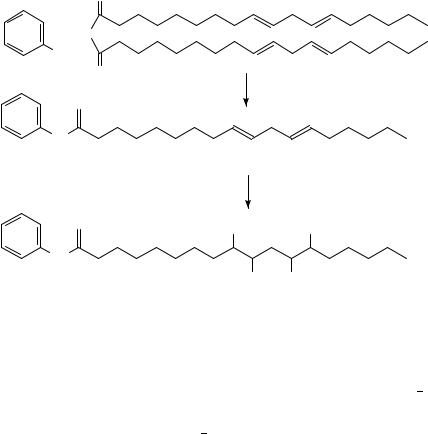
802 |
Mieczyslaw |
Zielinski´ and Marianna Kanska´ |
reference compound. This chromatographic isotope effect has been also observed in the case of deuteriated analogue and the elution order tritiated < deuteriated < hydrogenated has been established.
The model compound anilinostearamide 78, labelled in the aliphatic chain only, prepared subsequently by the reduction of linoleic precursor 79 with hydrogen or deuterium (equation 30), exhibited a chromatographic isotope effect of similar magnitude. The labelled compound elutes on the reversed-phase HPLC prior to the unlabelled one.
O
+ O
NH2
|
O |
|
|
|
2. HPLC |
1. Toluene |
|
O |
|
|
|
NH |
|
|
(30) |
|
(79) |
|
|
|
X2 |
Pd / C, EtOA c |
|
O |
X |
|
X |
|
|
||
NH |
|
|
|
|
|
X |
X |
|
(78) X = H (100% yield); X = 2 H (100% yield) |
||
It has been suggested57 that the observed isotope effect arises from the differences in interaction between the C H and C D bonds and the stationary phase. The deuteriated compounds are less lipophilic than the unlabelled ones. The C D bonds are shorter, exhibit lower polarizabilities and have lower vibrational frequencies. The deuterium atoms behave as being smaller than hydrogen atoms. The C D bonds do not have as strong an attractive force to the stationary phase as do the C H bonds and therefore the deuteriated species are eluted faster on reversed-phase HPLC than the hydrogenated species59 64. The rigorous treatment of Vapour Pressure Isotope Effects (VPIE) and Chromatographic Isotope Effects developed by Bigeleisen65, van Hook66 and Devyatykh67 is presented in review articles and monograph chapters68 70.
B. Synthesis of Carbon-13-labelled Compounds
1. Synthesis of 10,15-[13C2]-Squalene, 80, and -DL-squalene oxide 81
10,15-[13C2]-Squalene, 80, has been produced71 in the reaction sequence shown in equation 31 which involves alkylation of 3-13C-ethyl acetoacetate with geranyl bromide, followed by hydrolysis, decarboxylation and treatment with triethyl phosphonoacetate and then reduction of the ester 82 with LiAlH4, bromination with CBr4/PPh3 and coupling the farnesyl bromide with Cul/Li-pyrrolidine. Epoxidation of 80 has been effected by
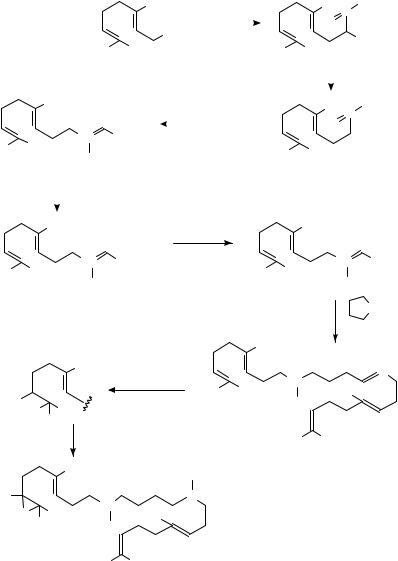
18. Syntheses and uses of isotopically labelled dienes and polyenes |
803 |
treatment with NBS in aqueous THF followed by elimination of HBr with K2CO3.
* |
|
+ |
Me |
|
NaOEt / EtOH |
|
Me*C |
Me |
|||||||||
MeCCH2 COOEt |
|
|
|
|
|
|
|
|
|
|
O |
|
|||||
|
|
Br |
|
|
|
|
|
|
COOEt |
||||||||
|
|
|
|
|
|
|
|
|
|
|
|
|
|
|
|||
|
|
|
|
|
|
|
|
|
|
|
|
|
|
|
|
|
|
O |
Me |
Me |
|
|
|
|
|
|
|
Me |
Me |
||||||
|
|
|
|
|
|
|
|
||||||||||
|
|
|
|
|
|
|
|
|
|
|
|
||||||
|
|
|
|
|
|
|
|
|
|
|
|
|
|
|
|||
|
|
|
|
|
|
|
|
|
|
|
|
|
|
DMSO / 160 °C |
NaCl / H2 O |
||
|
|
Me |
|
|
|
|
|
|
|
|
|
|
|
|
|
Me |
|
|
|
|
|
|
|
|
|
|
|
|
|
|
Me*C |
||||
|
|
|
|
|
|
|
NaH / DMM |
|
|
||||||||
|
|
|
|
|
|
|
|
O |
|
||||||||
|
|
|
|
*C |
COOEt |
|
|
O |
|
|
|
|
|||||
|
|
|
|
|
|
|
|
|
|
|
|
||||||
Me Me |
(EtO)2 |
|
|
|
|
|
|
|
|
|
|||||||
Me |
|
|
PCH2 |
COOEt |
Me |
Me |
|
||||||||||
|
|
|
|
|
|
|
|
|
|
|
|
|
|
||||
(82) |
|
|
|
|
|
|
|
|
|
|
|
|
|
||||
|
|
|
|
|
|
|
|
|
|
|
|
|
|
||||
|
|
|
LiA lH4 / Et2 O |
|
|
|
|
|
|
|
|
|
|
|
|||
|
|
|
|
|
|
|
|
|
|
|
|
|
|
||||
|
|
|
|
|
|
|
|
|
|
|
|
|
|
|
|
|
|
|
|
Me |
|
|
|
|
|
|
|
|
|
|
|
Me |
|
||
|
|
CBr4 / PPh3 |
|
|
|
|
MeCN |
|
|
Me |
*C |
CH2 OH |
Me |
*C |
Me |
|
Me |
||
|
Me |
|
|
Me |
|
|
|
|
1. |
|
|
|
|
Et2 O, 0 °C |
|
|
|
|
2. CuI |
|
|
|
Me |
|
|
Me |
|
|
|
|
|
NBS / aq. THF |
Me |
*C |
|
|
Me |
Me |
|
Br |
|
under N2 |
|
Me |
HO MeMe |
|
|
||
|
|
|
|
|
RT, 2 h under N2 K2 CO3 / MeOH |
|
Me Me |
||
|
Me |
|
|
(80) |
|
Me |
|
|
|
|
|
|
|
|
H |
*C |
*C |
|
|
|
|
|
|
|
O |
Me |
|
|
|
|
MeMe |
|
|
|
|
Me |
|
|
|
|
Me |
Me |
|
|
|
(81) |
|
|
|
*C = |
[R, S]squalene oxide |
|
|
|
13 C |
|
|
|
|
DMM = dimethoxymethane
CH2 Br
NH / n-BuLi
*C
31
The 13C-labelled squalene has been used71 to study the mechanism of its enzymatic conversion to lanosterol (3-ˇ-hydroxy-8,24-lanostadiene72) by yeast squalene-oxide lanosterol
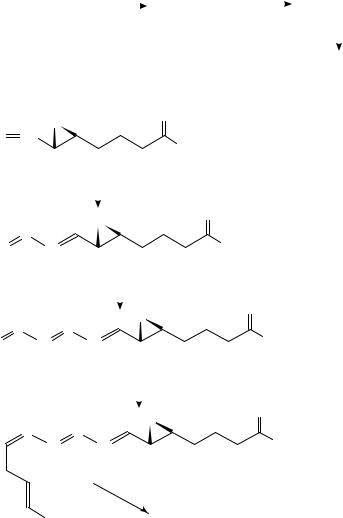
804 |
Mieczyslaw |
Zielinski´ and Marianna Kanska´ |
cyclase and it will be utilized in the future for preparations of labelled steroid analogues commercially unavailable.
2. Synthesis of [8,9,10,11-13C4 ]leukotriene C4
The title compound, [8,9,10,11-13C4]LTC4, 83, an ideal internal standard for GC/MS and other MS determinations of cysteine containing leukotrienes which show biological effects at very low concentration, such as smooth muscle contraction and hypersensitivity reactions73, has been obtained74 in a reaction sequence shown in equations 32a and b.
* |
|
|
|
DIBA H, CH2 Cl2 |
* |
|
Ph3 P, MeCN |
|
− |
+ * |
|
|
|
|
||||||
BrCH2 |
*COOEt |
|
|
|
|
|
|
BrCH2 *CHO |
|
|
|
BrPh3 PCH2 |
*CHO |
|
||||||
|
|
|
|
|
reflux |
|
|
|||||||||||||
|
− 78 °C |
|
|
|
|
|
||||||||||||||
|
|
|
|
|
|
|
|
|
|
|
|
|
|
|
|
|
||||
|
|
|
|
|
|
|
|
|
|
|
|
|
|
|
|
|
|
|||
|
|
|
|
|
|
|
|
|
|
|
|
|
|
|
|
Et3 N |
(32a) |
|||
|
|
|
|
|
|
|
|
|
|
|
|
|
|
|
|
|
|
|
|
|
|
|
|
|
|
|
|
|
|
|
|
|
|
|
|
|
|
|
|
||
|
|
|
|
|
|
|
|
|
|
|
|
Ph3 P |
|
*CH*CH |
|
O |
||||
|
|
|
|
|
|
|
|
|
|
|
|
|
|
|||||||
|
|
|
|
|
|
|
|
|
|
|
|
|
|
|||||||
|
|
|
|
|
|
|
|
|
|
|
|
|
|
|
(84) |
|
|
|
|
|
|
|
O |
|
|
|
|
|
|
O |
|
|
|
|
|
|
|
|
|
|
|
|
|
|
|
|
|
|
|
|
|
|
|
|
|
|
|
|
|
|
|
|
O |
CH |
|
|
|
|
|
|
|
OMe |
|
|
|
|
|
|
|
|
|
|
|
|
|
|
|
|
|
|
|
|
|
|
|
|
|
|
|
|
|
|
|
|
|
|
|
|
(85) |
|
|
|
|
|
|
|
|
|
|
|
|
|
|
|
|
|
|
|
|
|
|
|
|
|
|
|
|
|
|
|
|
|
|
|||
|
|
|
|
reflux |
84, toluene |
|
|
|
|
|
|
|
|
|
|
|
||||
|
|
|
|
|
|
|
|
|
O |
|
|
|
|
|
|
|
|
|
|
|
|
|
|
|
O |
|
|
|
|
|
|
|
|
|
|
|
|
|
|||
|
|
|
|
|
|
|
|
|
|
|
|
|
|
|
|
|
|
|||
*C |
|
|
|
|
|
|
|
|
OMe |
|
|
|
|
|
|
|
|
|
||
O |
|
*C |
|
|
|
|
|
|
|
|
|
|
|
|
|
|
|
|
||
|
|
|
|
(86) |
|
|
|
|
|
|
|
|
|
|
|
|
|
|
||
|
|
|
|
|
|
|
|
|
|
|
|
|
|
|
|
|
||||
|
|
|
|
reflux |
84, toluene |
|
|
|
|
|
|
|
|
|
|
|
||||
|
|
|
|
|
|
O |
|
O |
|
|
|
|
|
|
|
|
(32b) |
|||
|
|
|
|
|
|
|
|
|
|
|
|
|
|
|
||||||
|
|
|
|
|
|
|
|
|
|
|
|
|
|
|
|
|||||
*C |
*C |
|
|
|
|
OMe |
|
|
|
|
|
|
|
|
||||||
O |
|
*C |
|
*C |
|
|
|
|
|
|
|
|
|
|
|
|
|
|||
|
|
|
|
(87) |
|
|
|
|
|
|
|
|
|
|
|
|||||
|
|
|
|
HMPA , THF |
|
Z-3-nonene-1-triphenylphosphorane |
|
|
|
|
|
|
|
|
|
|||||
|
|
|
|
|
|
|
|
|
|
|
|
|
|
|||||||
|
|
|
|
|
|
|
|
O |
|
O |
|
|
|
|
|
|
|
|
|
|
|
|
|
|
|
|
|
|
|
|
|
|
|
|
|
|
|
|
|||
|
|
|
|
|
|
|
|
|
|
|
|
|
|
|
|
|
|
|
||
*C |
|
*C |
|
|
|
|
OMe |
|
|
|
|
|
|
|||||||
|
|
*C |
|
*C |
|
|
|
|
|
|
|
|
|
|
||||||
|
|
|
|
|
1. Glutathione, NEt3 , MeOH |
|
|
|
|
|
|
|
|
|
|
|
||||
|
|
|
|
2. LiOH |
|
|
|
|
|
|
|
|
|
|
|
|
|
|
||
|
|
C5H11 |
|
[8, 9, 10, 11- 13 C4 ] LTC4 |
|
|
|
|
|
|
|
|
|
|||||||
* = 13 C |
|
|
|
|
|
|
|
|
|
|
|
|
||||||||
|
|
|
|
|
(83) |
|
|
|
|
|
|
|
|
|
|
|
||||
